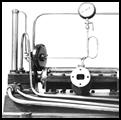
|
|
||||||||
Sir Charles Algernon Parsons (1854-1931)
 Described
as one of the greatest engineers that this country has ever produced,
Charles Parsons attended lectures given by James Stuart on Mechanisms
and Applied Mechanics in 1877, when he graduated after taking the Mathematical
Tripos at St John's.
Described
as one of the greatest engineers that this country has ever produced,
Charles Parsons attended lectures given by James Stuart on Mechanisms
and Applied Mechanics in 1877, when he graduated after taking the Mathematical
Tripos at St John's.
At this time, the generation of large amounts of power was posing a difficult problem. The steam engines that were used were so large and noisy that a power station in Manchester had to be closed down because of objections to the noise.
 Parsons,
amongst others, realised the need for a rotating machine or turbine to
convert the power of steam directly into electricity. He built his first
multi-stage reaction turbine in 1884, (see opposite) when he
became a junior partner in the firm Clarke, Chapman and Parsons.
Parsons,
amongst others, realised the need for a rotating machine or turbine to
convert the power of steam directly into electricity. He built his first
multi-stage reaction turbine in 1884, (see opposite) when he
became a junior partner in the firm Clarke, Chapman and Parsons.
He and his partners saw the potential for a steam turbine to drive electrical generators. He also had to produce the generator. The first turbo-generators, ranged in output from 1-75 kW. Three 4 ton 100kW radial flow generators were installed in Cambridge Power Station in 1895, and used to power the first electric street lighting scheme in the city.